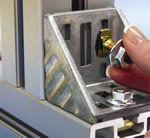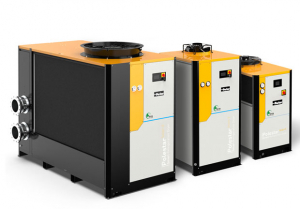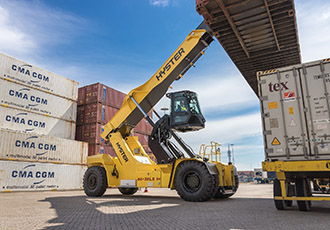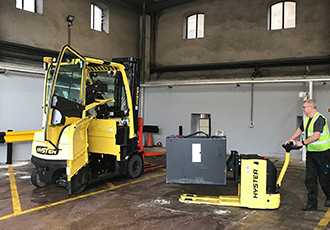Aluminium Structural Framing from Bosch Rexroth
24th July 2008
Source:
Bosch Rexroth

Space elevator. It sounds like something from a science fiction novel, but in fact it is a very real structure proposed by very real scientists, engineers, and space enthusiasts. Kevin Gingerich gives details of the task in hand and how Bosch Rexroth’s innovative technology is helping it become reality.
Hosted by the Spaceward Foundation, a non-profit organisation dedicated to furthering space science and technology, the Space Elevator Games unite the academic, commercial and educational minds together for a series of challenges designed to rekindle the nation’s interest in space. Since the inaugural event back in 2005, these annual games have grown in popularity but have still had no winner – this year’s pot stands at $4 million!
Essentially, a space elevator is a fixed structure that uses a climbing mechanism to transport material from the earth’s surface into space. Construction of such a structure may seem like a daunting task, but organisations like the Spaceward Foundation are hoping to advance the technology with contests like the Space Elevator Games.
One technique of erecting the fixed structure of the space elevator is by using a form of tethering method. The Space Elevator tether is a thin ribbon, with a cross-section area roughly half that of a pencil, extending from a ship-borne anchor to a counterweight well beyond geo-synchronous orbit. The climbing mechanism can then travel along the tether beyond Earth’s gravitational pull without the use of rocket propulsion. Theoretically, the space elevator could then deliver cargo and people into orbit at a fraction of the cost of traditional launching methods.
“Right now the technology to complete a space elevator does not exist,” said Ben Shelef, aerospace engineer and co-founder and leader of the executive crew of the Spaceward Foundation. “The purpose of the Space Elevator Games is to get the right people in industry and academics thinking about how we can make this work and to stimulate the development of new technologies to make the structure a reality.”
The Strong Tether Competition – a $2 million technology challenge backed by NASA – is just one of the events in the Space Elevator Games. Designed for developing a new class of super-strong tethers, a tether pull machine was developed specifically for testing and measuring the tensile strength of each of the team’s proposed elevator tethers. The competition requires a 50 percent improvement in breaking force from year to year, and started with a commercially available tether when the contest began.
“The tether pull machine is designed to run a comparative test between two tether samples,” explained Shelef. “One of the decisions made early on in the programme was that we wanted to make tether testing an exciting business to watch, so we created a head-to-head strength competition.”
For this purpose Shelef and his team designed what is essentially a tug-of-war machine. The tether pull machine grabs two tether samples at their respective ends, and then pulls their free ends towards each other. Since the pulling mechanism floats, the resultant force on the tethers is equal, and as the force increases, one will break first “and with a very loud bang!” noted Shelef. The remaining tether, along with the pull mechanism, will lunge the other way and clearly indicate a winner.
The tether machine itself comprises a rectangular box structure about 12-feet long and 18-inches high on each side. “It has sliding parts, it needed to look sleek, and from our experience as designers, Rexroth’s aluminium structural framing system was the natural way to go as the material to build the machine,” said Shelef.
Using Rexroth bolt-together connectors, the tether pull structure can be quickly assembled by the team without special tools or skills and the extruded aluminium framing looks clean and attractive without painting or other finishing. The team could also choose from a broad selection of Rexroth accessories to extend the machine beyond a simple frame and base to a complete multi-functional structure. And, every aluminium structural framing component is reusable, which made it simple for the team to change the tether pull machine as their design needs developed and changed.
The Strong Tether challenge is conducted in two rounds. The first round pits tethers from two teams directly against each other to determine the team with the strongest tether. The second round then determines if the first-round winner is at least 50 percent stronger than a “house” tether that represents off-the-shelf materials. If it is, that team will win the competition.
“I specifically requested the Rexroth aluminium structural framing because it could provide 60 times the strength of steel, yet it is also five times lighter than steel,” explained Shelef. “The aluminium structural framing was able to meet our performance criteria while also allowing us to assemble the tether machine quickly and easily.”
A last-minute request from Shelef, when the Spaceward Foundation team was passing through Phoenix on its way to the competition, put Bosch Rexroth’s service levels and expertise to the test. Incredibly, the team had not yet finalised the project parts list and needed help fast. All in all it was a great joint effort between Bosch Rexroth and its local sales partner to come through for the team and have the aluminium extrusions machined and kitted in less than 24 hours.
At last year’s Space Elevator Games, held at NASA’s Ames Research Center in Mountain View, California, the Spaceward Foundation team again called upon one of Bosch Rexroth’s local sales partners to supply the structural framing. In the months leading up to the competition, order changes and additions as well as multiple short lead time deliveries were accommodated successfully, confirming their overall commitment to the project.
Essentially, a space elevator is a fixed structure that uses a climbing mechanism to transport material from the earth’s surface into space. Construction of such a structure may seem like a daunting task, but organisations like the Spaceward Foundation are hoping to advance the technology with contests like the Space Elevator Games.
One technique of erecting the fixed structure of the space elevator is by using a form of tethering method. The Space Elevator tether is a thin ribbon, with a cross-section area roughly half that of a pencil, extending from a ship-borne anchor to a counterweight well beyond geo-synchronous orbit. The climbing mechanism can then travel along the tether beyond Earth’s gravitational pull without the use of rocket propulsion. Theoretically, the space elevator could then deliver cargo and people into orbit at a fraction of the cost of traditional launching methods.
“Right now the technology to complete a space elevator does not exist,” said Ben Shelef, aerospace engineer and co-founder and leader of the executive crew of the Spaceward Foundation. “The purpose of the Space Elevator Games is to get the right people in industry and academics thinking about how we can make this work and to stimulate the development of new technologies to make the structure a reality.”
The Strong Tether Competition – a $2 million technology challenge backed by NASA – is just one of the events in the Space Elevator Games. Designed for developing a new class of super-strong tethers, a tether pull machine was developed specifically for testing and measuring the tensile strength of each of the team’s proposed elevator tethers. The competition requires a 50 percent improvement in breaking force from year to year, and started with a commercially available tether when the contest began.
“The tether pull machine is designed to run a comparative test between two tether samples,” explained Shelef. “One of the decisions made early on in the programme was that we wanted to make tether testing an exciting business to watch, so we created a head-to-head strength competition.”
For this purpose Shelef and his team designed what is essentially a tug-of-war machine. The tether pull machine grabs two tether samples at their respective ends, and then pulls their free ends towards each other. Since the pulling mechanism floats, the resultant force on the tethers is equal, and as the force increases, one will break first “and with a very loud bang!” noted Shelef. The remaining tether, along with the pull mechanism, will lunge the other way and clearly indicate a winner.
The tether machine itself comprises a rectangular box structure about 12-feet long and 18-inches high on each side. “It has sliding parts, it needed to look sleek, and from our experience as designers, Rexroth’s aluminium structural framing system was the natural way to go as the material to build the machine,” said Shelef.
Using Rexroth bolt-together connectors, the tether pull structure can be quickly assembled by the team without special tools or skills and the extruded aluminium framing looks clean and attractive without painting or other finishing. The team could also choose from a broad selection of Rexroth accessories to extend the machine beyond a simple frame and base to a complete multi-functional structure. And, every aluminium structural framing component is reusable, which made it simple for the team to change the tether pull machine as their design needs developed and changed.
The Strong Tether challenge is conducted in two rounds. The first round pits tethers from two teams directly against each other to determine the team with the strongest tether. The second round then determines if the first-round winner is at least 50 percent stronger than a “house” tether that represents off-the-shelf materials. If it is, that team will win the competition.
“I specifically requested the Rexroth aluminium structural framing because it could provide 60 times the strength of steel, yet it is also five times lighter than steel,” explained Shelef. “The aluminium structural framing was able to meet our performance criteria while also allowing us to assemble the tether machine quickly and easily.”
A last-minute request from Shelef, when the Spaceward Foundation team was passing through Phoenix on its way to the competition, put Bosch Rexroth’s service levels and expertise to the test. Incredibly, the team had not yet finalised the project parts list and needed help fast. All in all it was a great joint effort between Bosch Rexroth and its local sales partner to come through for the team and have the aluminium extrusions machined and kitted in less than 24 hours.
At last year’s Space Elevator Games, held at NASA’s Ames Research Center in Mountain View, California, the Spaceward Foundation team again called upon one of Bosch Rexroth’s local sales partners to supply the structural framing. In the months leading up to the competition, order changes and additions as well as multiple short lead time deliveries were accommodated successfully, confirming their overall commitment to the project.
Similar articles
More from Bosch Rexroth
- Bosch Rexroth confirms partnership for Maintec 2018 21st May 2018
- Setting IoT into motion with working hydraulics 12th April 2018
- VR interactive rally car simulator at Industry 4.0 Summit 20th February 2018
- Technology protects hydraulic systems and reduces operating costs 27th March 2017




.jpg)







Write a comment
No comments